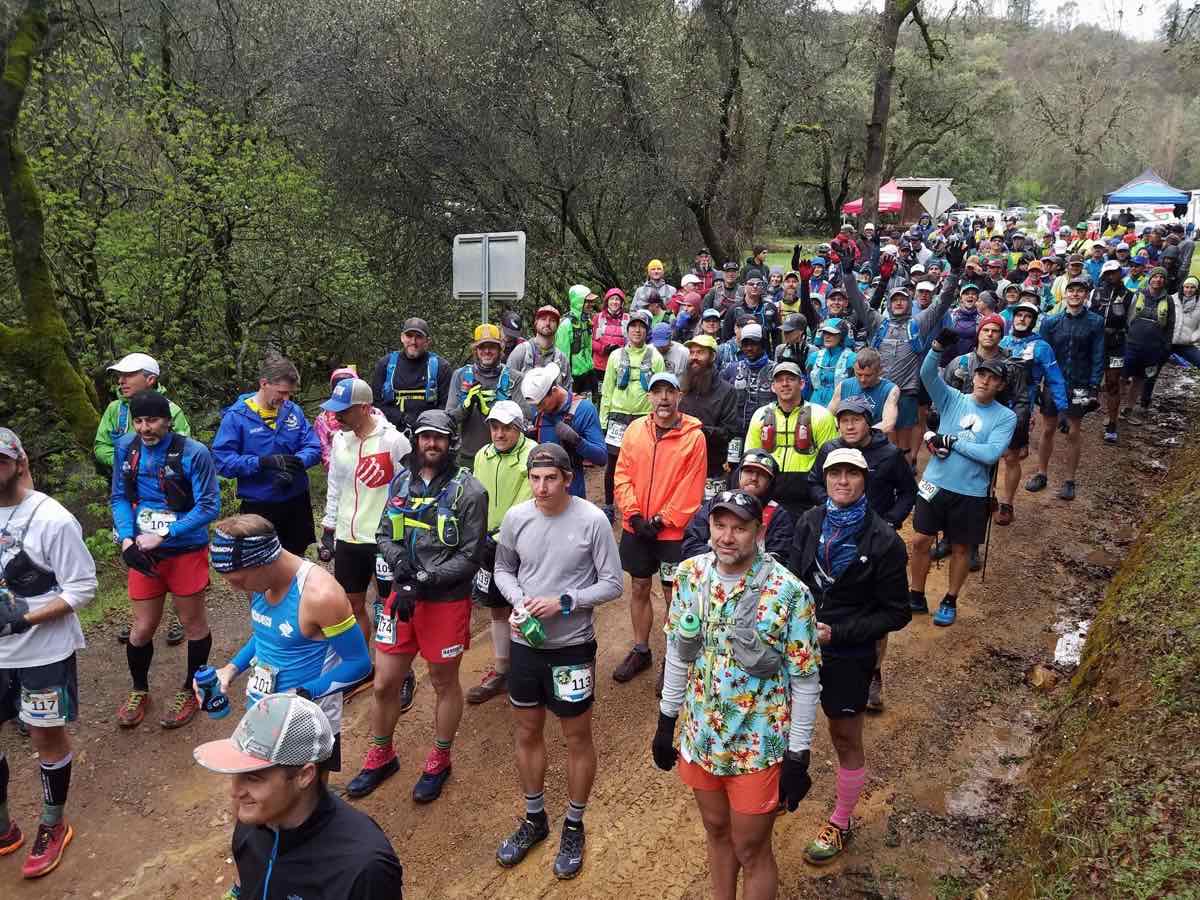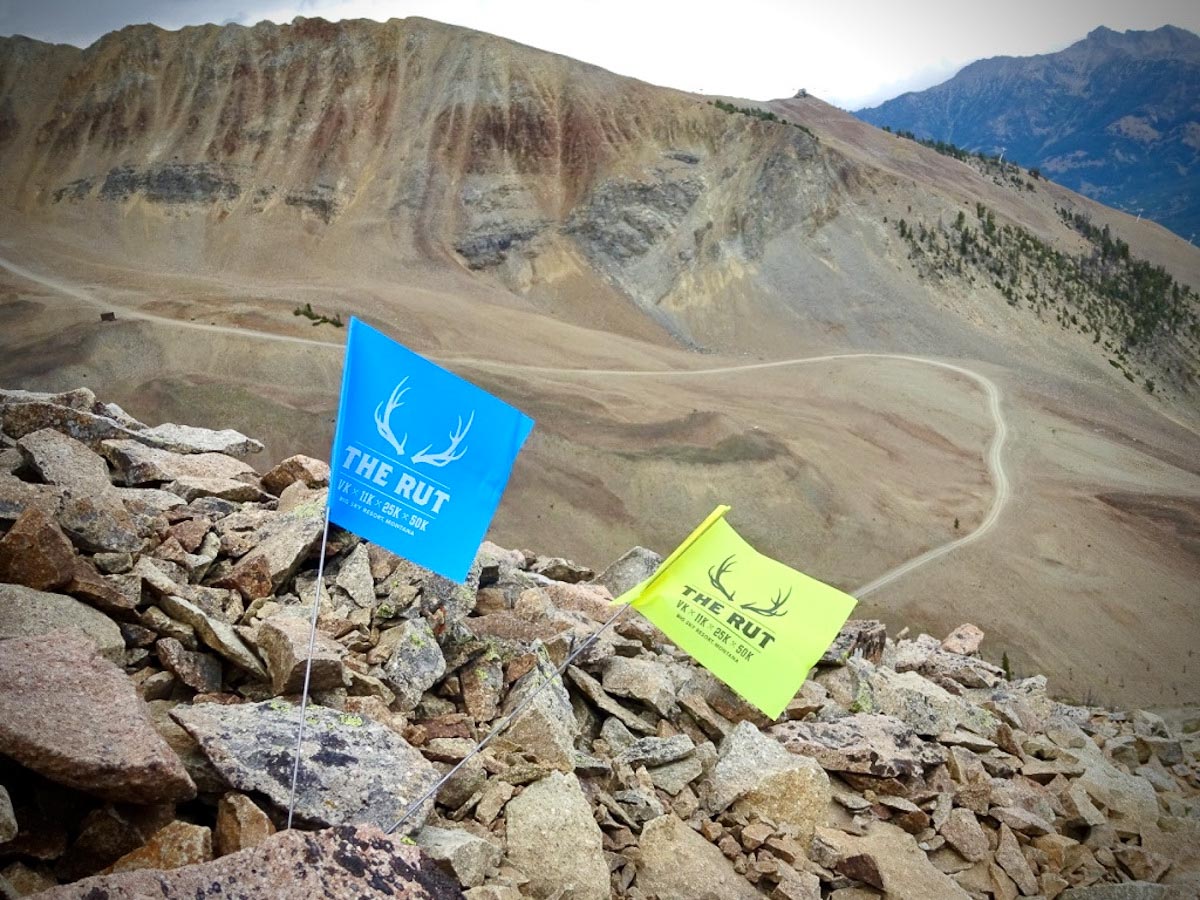
If you enjoy this article, then get your own copy of the book “Where the Road Ends!”
Welcome to this month’s edition of “Where the Road Ends: A Guide to Trail Running,” where we help you plan for your first trail race!
“Where the Road Ends” is the name of both this column and the book Meghan Hicks and Bryon Powell of iRunFar published in 2016. The book Where the Road Ends: A Guide to Trail Running is a how-to guide for trail running. We worked with publisher Human Kinetics to develop a book so anyone can get started, stay safe, and feel inspired on the trail.
The book teaches you how to negotiate technical trails, read a map, build your own training plan, understand the basics of what to drink and eat when you run, and so much more. This column aims to do the same by publishing sections from the book, as well as encouraging conversation in the comments section of each article.
In this article, we bring you an excerpt from Chapter 12 about trail racing and how to prepare for it. Last month, we offered some tips on preparing for your race ahead of time. In this article, we share some race-day tips to help you have your best day out.
Starting Lines
By its nature, trail running takes us to remote places off the beaten path. Accordingly, you might need to follow a convoluted and confusing route to the starting line of a trail race. Just getting to it may feel like a twisty, winding trip on singletrack. Most race websites provide good instructions for getting to the start with maps and written directions.
If you navigate to the starting line with a GPS device, use it to confirm your location relative to the instructions provided. Don’t rely entirely on your GPS unit because GPS devices aren’t always able to route you correctly through remote areas. Make sure to leave plenty of extra time for the meandering and mistaken turns that might be part of this journey.
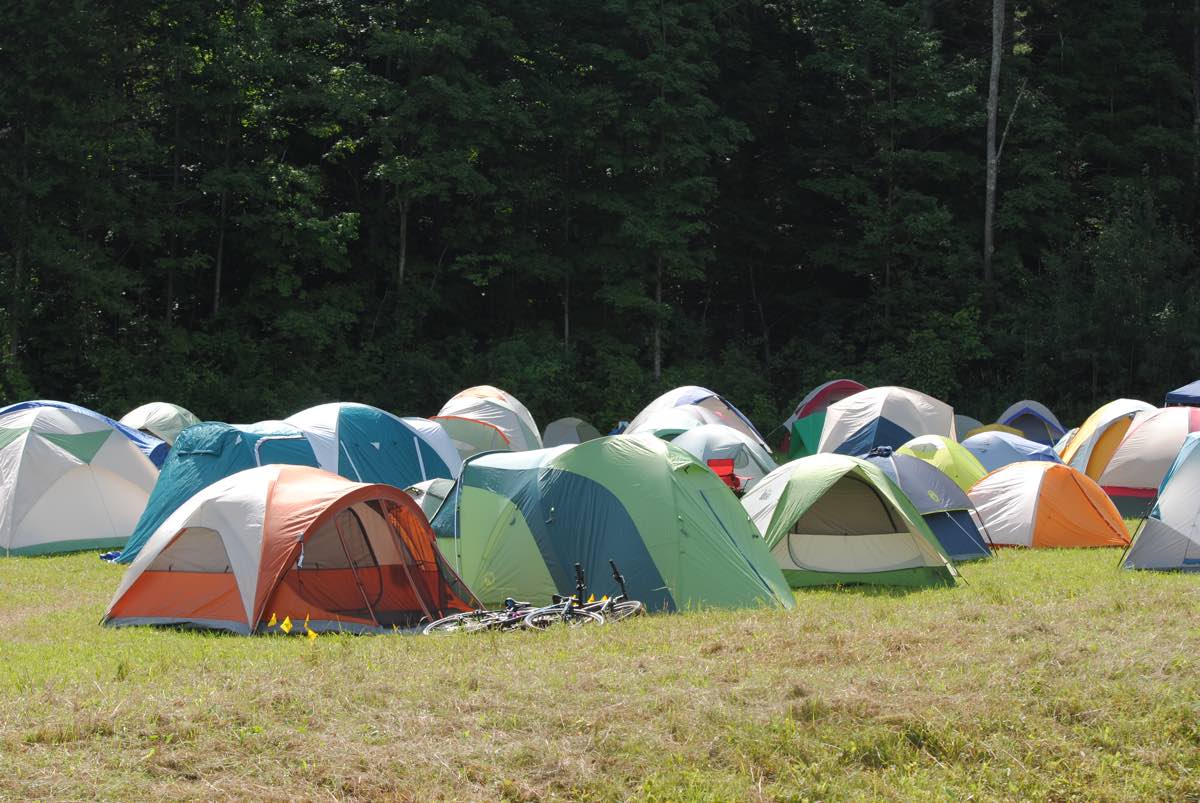
Tent city at the 2018 Vermont 100 Mile start/finish area. Some trail races provide designated camping areas, which can be useful if your race is somewhere remote and/or starts very early. Photo: Dave Priganc
Parking for all but the largest trail races, which we discuss later, is typically straightforward, if occasionally messy. Usually, race volunteers point you toward an empty parking spot, but be prepared for this parking spot to be off road, maybe in a grassy or muddy field. Depending on the layout of the starting line and the parking area, you might have to walk a fair distance from your car to the line. Budget time for this.
Those who are familiar with road racing will have a similar image come to mind when we mention starting-line restrooms: a long row of portapotties with a longer line of waiting runners. The restroom situation at the starting line of a trail race might be similar to this or quite different. Sometimes you will encounter that same line of portapotties, whereas other times you will have access to a restroom at a trailhead or visitor center. You will likely have to wait your turn, so build some restroom time into your pre-start plan. You may or may not have a way to clean your hands after using the bathroom, depending on how simple the facilities are. Consider bringing hand sanitizer or baby wipes just in case.
At a trail race start, you will need to check in as well as pick up your bib number and maybe some swag like a shirt or a hat. Sometimes races offer check-in the night before at a local running store or hotel, but others offer check-in only at the starting line. Even if you’ve checked in before race morning, you may need to check in again on race day so that the race has an accurate list of who is on the course. Make sure to note all this from the race website. Again, check-in can take time, so arrive with enough time to accomplish it.
Because trail races often funnel straight onto singletrack with little room for passing, you need to seed yourself among your peers. Should you seed yourself too far ahead in the pack, you’ll likely be stuck running in a train of runners who are too fast, which could make the second half of your race a painful, slow slog. If you seed yourself too far back, you’re apt to waste time waiting for those ahead of you to negotiate the terrain. To seed yourself appropriately, estimate the size of the crowd and place yourself in it according to your previous race results. For example, if you often finish around the top 30%, place yourself behind roughly one third of the runners.
When you find yourself needing to negotiate a pass or to allow other runners to pass you, err on the side of caution and respect for others. If you would like to pass another runner, politely ask the person ahead of you for permission. When the trail allows, the person should step aside to let you go by. If another runner wants to pass you, offer the same little step off the trail as soon as it’s safe to do so. A little kindness goes a long way, in life and on the trail.
Staying on Course
The thing that varies the most from trail race to trail race is how courses are marked. Although you won’t find consistency from race to race, the website or the pre-race briefing are perfect places to find out exactly how a course will be marked. Most courses are marked at least in part with inch-wide (2.5 cm wide) colored ribbon known as flagging.
Flagging is hung from trees, shrubs, grass, and permanent trail markers. Most often, flagging is hung to delineate the path you are to travel. Flagging comes in many colors, but pink, orange, and yellow are frequently used at trail races. Generally, race directors use the same-color flagging from start to finish to delineate the course.
Some events hold races of multiple distances, so race directors often use flagging of different colors for the different races. Make sure you know the flagging color you are to follow. Occasionally, races use small flags or reflective markers hanging from flagging or attached to thin metal stakes in the ground.
A race director might supplement flagging with additional markers, such as flour arrows or plastic plates with arrows directing where you should go, particularly at intersections. Sometimes, wrong-way signs, differently colored ribbons, or branch barricades are placed on the trails you shouldn’t take.
In an ideal marking situation, a race director marks the course at regular intervals with what we call confidence markers, say every quarter- or half-mile (every half or full kilometer). These markers provide affirmation that you are going in the right direction over expected and regular periods. If you don’t recall seeing a marker for a while, you can begin actively looking for one. If you then don’t see one in slightly longer than the intervals you have previously, you may want to turn around if no other runners around you can confidently say that you’re still on course.
If you keep your eyes peeled, you are unlikely to have issues navigating.
Aid-Station Expectations
Aid stations are beacons of hope that offer water, food, and friendly faces in remote locations. Although aid-station layouts vary from race to race and even from station to station within a single race, you’ll find certain mainstays among them all.
Most likely, volunteers will record your passage manually or by chip and timing mat, so that the race can track each runner’s location. This usually happens as you enter or leave an aid station. Do what you can to facilitate this process.
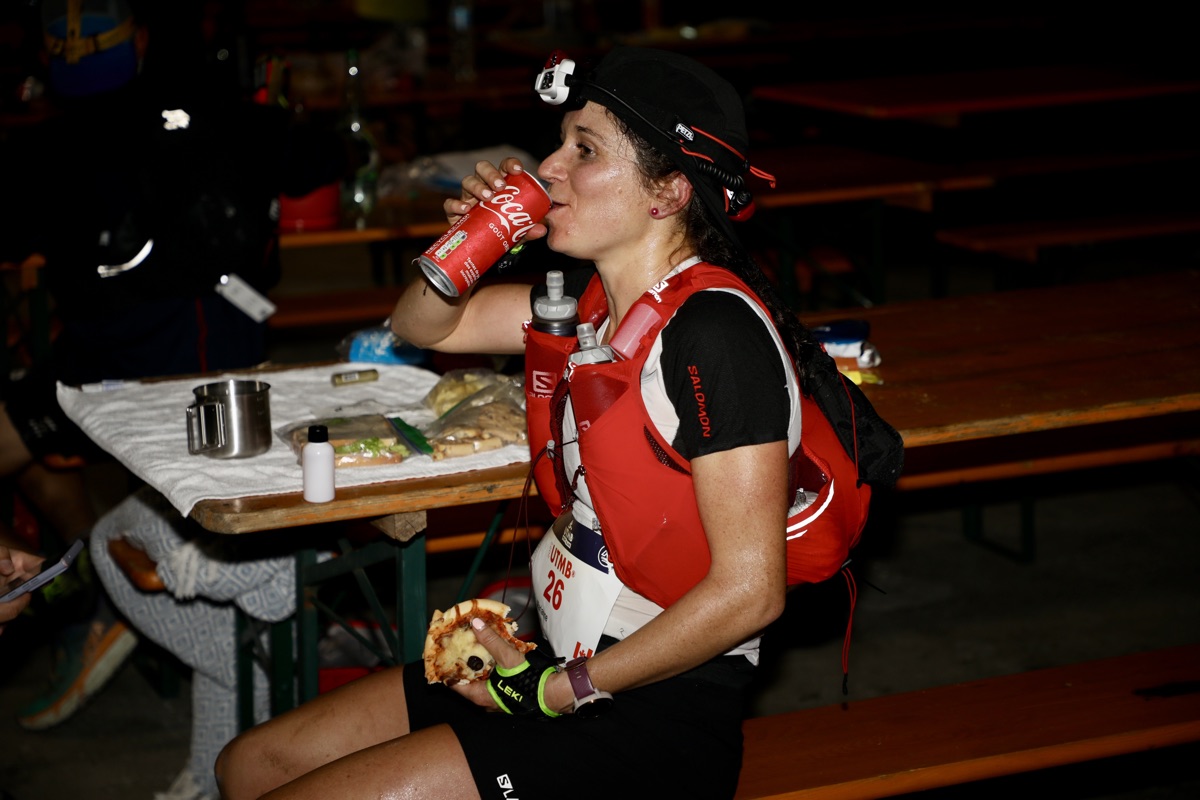
Marianne Hogan enjoying pizza and Coke at the Courmayeur aid station during the 2022 UTMB. Photo: iRunFar/Bryon Powell
Next, take care of your hydration. You’ll generally find that drinks are available from already poured cups and from large jugs. Water, sports drinks, and soda are common hydration offerings at aid stations. At a short race, you may just want to stay a moment and sip on a glass of water or sports drink.
For longer races, you want to do the same while also refilling a handheld water bottle or hydration pack from a jug. Swigging a bit of soda can add a jolt of energy for the coming section, although many runners save this for late in a race. Sometimes, aid stations offer ice for longer or hotter races. If so, add it to your bottle or hydration pack. Note that if you’re participating in a “cupless” race, you’ll need to provide your own drinking and water-storage containers and you won’t find drinks awaiting you in cups.
You’ll likely find a table full of easy-to-eat snacks, usually including salty foods like salted potatoes, chips, and pretzels, and sweet foods like gels, gummy bears, cookies, and hard candies. At longer trail races, like a trail marathon, you might find more substantive food like soup, grilled cheese, bacon, and pancakes.
Aid stations supply garbage bags or cans. If recycling or composting containers are provided, use them appropriately.
Some aid stations will have a restroom, whether it’s an outhouse, portapotty, or backcountry setup. Also, many aid stations are staffed with medical personnel. Ideally, you won’t need their services, but knowing such help is available provides peace of mind.
Finally, before you leave, make sure to thank the aid station volunteers. Even better, volunteer to work at an aid station of another race to give back to those people who have helped you.
Finish Areas
Most trail runners love finish-line areas. You are done with the challenges of running. You can hang out with your friends, compare notes on the day, have a picnic, and enjoy food and beverages offered by the race. Sometimes races have live music and other activities. Many people find themselves having so much fun at the finish of a trail race that they stay there longer than the time it took them to run the race itself.
Be sure to pack supplies that will allow you to hang out after the race, be it clean and warm clothes to change into, a blanket or camp chairs to sit on, some of your own food and drink, and extra sunscreen.
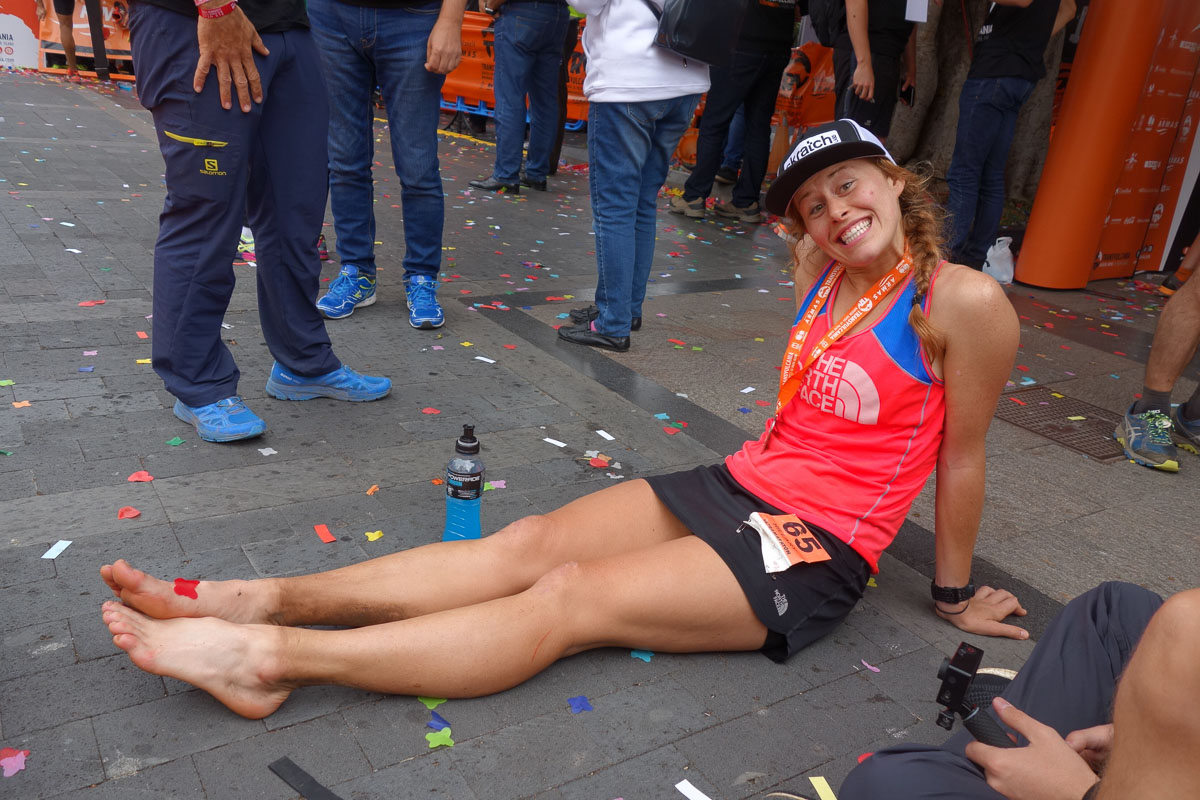
Hillary Allen letting her legs rest at the finish of the 2016 Transvulcania Ultramarathon. Hopefully, you’ll find a better seat than this one! Photo: iRunFar/Meghan Hicks
At most trail races, all finishers get some sort of prize, which is given out when you cross the finish line. A low-key award ceremony for the fastest runners will take place as part of the finish-line festivities. The number and kinds of awards vary from significant prize money for the top men and women to small gifts that extend through top age-group finishers.
Call for Comments
- Are you getting ready for your first off-road race? What questions do you have?
- For those of us who’ve run trail races before, what do you know now that you wish you’d learned before your first one?
